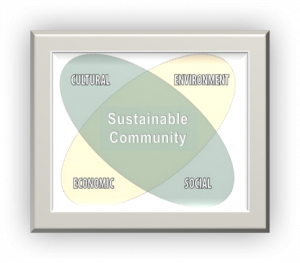Introduction
Culture and creativity are powerful, and the value they provide to our communities is being seen around the world now more than ever. Throughout the Covid-19 pandemic, many were forced to pause and reflect on how they do things and what is important to them as individuals and groups. As Ernesto Ottone Ramirez, Assistant Director-General for Culture at The United Nations Educational, Scientific and Cultural Organisation (UNESCO) describes in an episode of the Creative City Network of Canada mini-series podcast, culture has been “one of the essential sources of resilience and vitality in such trying circumstances. As we have observed, cities and people around the world turn to culture as a source of comfort, well-being and also connection” (Latham, 2020, para. 5).
Culture’s capacity to harness “the power to create, connect and inspire” (d’Orville, 2019, p. 69) plays a key role in developing and maintaining sustainable communities, where people of diverse backgrounds and perspectives feel welcome and safe as their communities seek to address “multiple human needs, not just one at the exclusion of others” (Institute for sustainable communities, n.d., para. 1). UNESCO has identified four pillars of sustainability (See figure1:3 Pillars of sustainability) which include the economic, environmental, social and cultural pillars, each playing a role in sustaining our local communities.

Culture is rooted in all of these aspects and there is incredible power in the interconnectivity of these pillars. We have seen this firsthand as we lived the impact of the Covid-19 pandemic. Ottone Ramirez argues that there is “a direct relationship between culture and social and psychological well-being.” This knowledge is held intrinsically by those working in this field, but right now, it seems evident that “people are [generally] more aware of the significance of what it means – culture for our daily livelihoods” (Latham, 2020, para.7).
As we begin to highlight the power of culture in creating sustainable communities, we must note that culture has also been identified as one of the three pillars of soft power. The term soft power, which we will explore in this chapter, refers to the concept of using a country’s ‘attractiveness’ to influence and achieve favoured outcomes. The challenge here is to understand the applicability of soft power in a local framework. What does it look like on a micro-level, and how can it be used in future to help us achieve the things we have highlighted as important to us as a society?
Throughout this chapter we will explore the value of culture and the role it plays in creating sustainable communities. We will share lived examples, stories and experiences which demonstrate how sharing and capitalising on the value of culture and exploring soft power can help you get things done as arts managers. This chapter also includes interviews with some of our colleagues working in the field who have generously shared their experience, as well as some valuable links to real life examples, articles and videos, for further reference.
